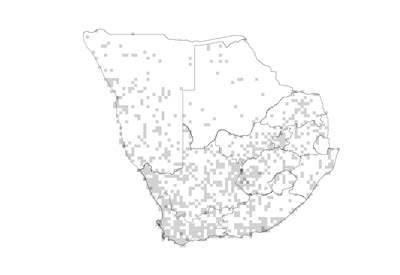 Species distribution and density. Darker squares represent higher density of members of this family. |
Introduction
Salt bush family
A large family with insignificant flowers, including important crops. Most members are adapted to grow in soils containing high concentrations of inorganic salts and are therefore dominant in salt marshes. Sometimes included in the Amaranthaceae but differs in having a membranous or succulent perianth versus a scarious one, and in having distinct filaments often united at the base into a hypogynous disc versus filaments united into a tube.
Distribution
Found worldwide in temperate and subtropical regions, particularly in saline habitats. In southern Africa the highest concentration is found in the drier, western parts of the region.
Number of genera in the world
ca. 102
Number of species in the world
ca. 1 500
Number of genera in the Flora of southern Africa region
14
Number of species in the Flora of southern Africa region
173
Well-known southern African genera
Atriplex, Manochlamys, Salsola
Growth forms
Mostly annual or perennial herbs or shrubs and rarely small trees.
Habitats
Many members of the family thrive on saline or alkaline soils in arid areas.
Flagship species
Manochlamys albicans (spanspekbos [A]) is a shrub with diamond-shaped leaves, widespread in the arid western parts of southern Africa. The minute, yellow flowers are clustered at the end of branches and appear during spring and summer. The succulent bracts that enfold the fruits were traditionally used as a soap substitute. It is a highly palatable plant and is an indicator of well-managed veld. (Photo: RDV).
Significance of the family
This family contains food plants like spinach (*Spinacia oleracea), chard and beetroot (*Beta vulgaris) and quinoa (*Chenopodium quinoa), a substitute for wheat/gluten. Some Chenopodium species are used as wild spinach (marog). In arid regions, certain species are important as fodder plants (Atriplex). Salsola generally comprises excellent grazing plants, but some species are reported to be poisonous to sheep. Others have traditionally been used in the soap-making process. Some members of the family are used medicinally to treat coughs, stomach aches and eczema; others are used as an insecticide (Chenopodium).
Diagnostic characters
Deeply penetrating roots are common. Leaves simple, mostly alternate , without stipules, often fleshy and covered with a 'powdery' indumentum . Flowers regular, minute , greenish and borne in spike-like or cymose inflorescences. Perianth of 2-5 tepals �. Ovary superior with 1 locule. Fruit a small nut or usually an achene enclosed in bracteoles or the perianth that become hard, fleshy, thorny or hooked.
Did you know?
The tuber of beetroot (*Beta vulgaris) is an important source of sucrose and accounts for almost 30% of the world's sugar production.